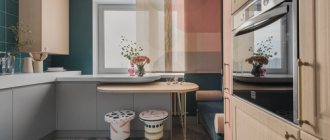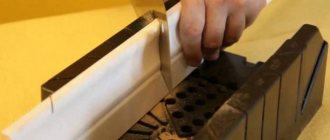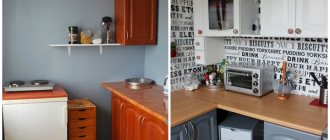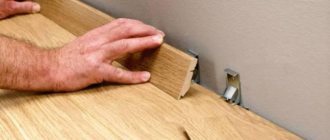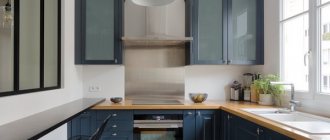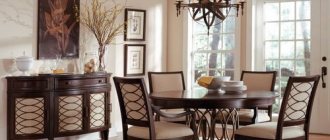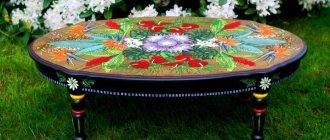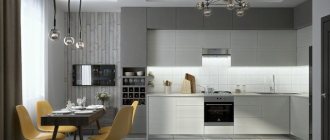The kitchen has been renovated, the dining table and kitchen furniture have been selected. Now it’s all up to the details and finishing touches, without which the room will not become harmonious and as resistant to splashes, constant exposure to moisture and temperature changes as possible. One of these parts is the kitchen plinth for the countertop. Often it comes complete with a kitchen set, but if you made custom-made furniture or simply decided to refresh your existing set, the question of choice will sooner or later become relevant. We suggest you understand the main types of baguettes for countertops and decide how to install a kitchen plinth.
No. 1. Functions of a kitchen plinth
The kitchen plinth is similar in structure and appearance to its floor counterpart. They cover the joint between the countertop and the wall (kitchen apron). Why is this necessary? For a number of reasons, because the kitchen plinth takes on a lot of functions:
- protecting the joint between the countertop and the wall from crumbs, splashes and debris . Even if all surfaces are perfectly flat, there may be a small gap between the kitchen unit and the wall. In most kitchens, deviations from ideal horizontals and verticals are significant, so very noticeable gaps can form. Debris and particles of moisture that will certainly get into the gap, in favorable kitchen conditions, will quickly become a place for the development of mold and mildew. Not only is it unhygienic, but the smell will be terrible;
- chipboard countertops (the ones that cost the least, which is why they have become popular) are very sensitive to moisture. To be more precise, moisture that gets onto the unprotected end . If it is hermetically covered with a plinth, then even the cheapest tabletop will last quite a long time;
- kitchen plinth perfectly hides all defects associated with uneven walls. The gaps between the kitchen unit and the wall can be significant, and if the walls are uneven, the size of the gap can vary noticeably in different parts. Molding will help to neatly hide this flaw;
- a correctly chosen plinth decorates the kitchen and makes the interior more harmonious and complete;
- Almost all kitchen baseboards have a place for laying an electrical cable , and the fact that at least some of the wires are disguised will only benefit the appearance of the kitchen.
From all this it is clear that the kitchen plinth is an important detail, the choice of which must be given attention.
Features of installing skirting boards
It is better if a specialist installs the aluminum skirting board, but if you are confident in your abilities, you can install it yourself. In this case, it is important that the baseboard fits neatly and tightly to the wall and the edge of the countertop. If all actions are performed correctly, this will hide all the flaws in the headset and walls.
When choosing, not only functional qualities are important, but also the aesthetics of the kitchen design.
Attention! If there is a large distance between the wall and the countertop, then the selected baseboard should be even wider to completely cover the gap.
Procedure:
- First you need to check the package.
- Using a saw with fine teeth, we cut the baseboard (the length of the baseboard should correspond to the size of the kitchen countertop).
- You need to make holes in the base part to mount it on the wall.
- Using fasteners, connect the base part of the plinth to the wall.
- To prevent water and dirt from getting onto the countertop, a rubber seal is used.
It is necessary to completely clean the surface of the countertop and wall from dust and debris - there should be no dirt left under the baseboard.
Important! It is not recommended to attach the base plank to the wall, since when the tabletop moves, dirt will get into the gap.
The job is done, now thanks to the aluminum baseboard the kitchen will always be in order.
The final stage of installation is gluing the decorative edge, if any.
Aluminum kitchen plinth can be a wonderful decorative element. Any housewife will find it convenient to work in the kitchen, and in the evening it will be pleasant to sit with a cup of tea.
An excellent combination is a countertop made of artificial stone and an aluminum baseboard in the color of the fittings.
No. 2. The most important basics for choosing kitchen baseboards
Most kitchen sets include a matching kitchen baseboard. However, not everyone may like the “default” option, and then you will have to choose the molding to your liking. The question of choice will also be faced by those who made the kitchen to order. In order for the kitchen plinth to look as harmonious as possible, when determining its color, material and texture, the following rules are followed:
- selection of skirting boards of the same material and/or color as the worktop. So, for example, stone countertops are perfectly complemented by stone baseboards, wooden ones – by wooden ones, but combinations of different materials are also possible. Plastic skirting boards can follow the pattern of any material, therefore they can be considered universal;
- selection of baseboards for kitchen fittings, sinks, railings or other parts. If the handles on the facades are made of bronze, then the plinth of the same color will look harmonious.
When a plinth is selected along with a kitchen set, you can immediately test several samples of baguette, attaching them to the kitchen modules and assess compatibility.
Why do you need a baseboard for a countertop?
Cleanliness in the kitchen does not always depend on the efforts of the housewife; no matter how hard you try to wash the countertops and cabinets, crumbs and vegetable peelings often get into the space between them. Removing them from these cracks is quite difficult; sometimes you have to move the kitchen set to do this.
An aluminum tabletop plinth is indeed more expensive than a plastic one, but this fact cannot be taken as a disadvantage.
Realizing the need to maintain cleanliness in the kitchen without moving furniture, experts suggested that housewives install kitchen baseboards. Therefore, today cleaning with it has become much easier.
Its price is justified by its higher strength and durability.
No. 3. Kitchen baseboard material
The most common options are plastic and aluminum. Stone, ceramic, wooden and MDF skirting boards are also sold.
Kitchen plinth made of plastic
Plastic skirting boards for countertops are produced on the basis of polyvinyl chloride by co-extrusion. From the molten mass you can create a plinth of any shape and size. The necessary decor is obtained either by dyeing in the mass, or laminated with a film simulating the texture of noble materials. Typically, molding is decorated to match different types of wood and stone types. The texture of the baguette may differ: if the products are glossy and matte, smooth and shagreen.
The main advantages of plastic skirting boards include:
- nice appearance and a wide variety of colors, so there should be no problems with selection - there is an option for any interior and set;
- affordable price. Plastic molding will cost less than others;
- ease of installation;
- availability of space for laying wires;
- high resistance to moisture and chemicals;
- resistance to corrosion and rotting;
- elasticity, due to which the plastic plinth can fit tightly against a slightly uneven wall. This type of plinth is also used when working with complex curved shapes.
Not without a fly in the ointment:
- plastic is afraid of high temperatures, so close proximity to the hob can be disastrous;
- at low temperatures, plastic becomes brittle and can be easily damaged, so it is not recommended to use it in the kitchens of country houses and other premises where people live irregularly;
- not the highest mechanical strength.
Aluminum kitchen baseboard for countertop
Looking ahead, we note that this is the most preferable option in terms of price and quality ratio . Aluminum plinth can have a polished, unpolished or embossed surface. They also produce aluminum moldings with a replaceable color insert. The latter is sold in a small roll, is glued after installing the baseboard and, when dirty, can be removed and replaced with a new one. This color finish is chosen to match the color of the set, countertop or other elements.
The main advantages of aluminum skirting boards:
- high mechanical stability;
- heat resistance, so the distance to the kitchen stove can be minimal - the baseboard will not be damaged;
- resistance to chemicals, sunlight and moisture;
- ease of care;
- high durability;
- ease of installation;
- Great looks and versatility. An aluminum baseboard will look great with most countertops made from cheap materials, and will also be a harmonious addition to expensive stone countertops.
The downside is the price, but the difference in cost between plastic and aluminum skirting boards is not very significant.
Designers recommend combining an aluminum plinth for the tabletop with the same base plinth - it will look balanced and harmonious.
Kitchen plinth made of other materials
In addition to the most popular plastic and aluminum models, you can also choose a more exclusive skirting board:
- A solid wood kitchen plinth will be a beautiful addition to a wooden countertop. Everything will look gorgeous, but even the least active culinary processes will be accompanied by splashes of water and dirt, which will have a detrimental effect on the wood. If it is impossible to choose another material, then the molding will need to be very well treated with protective varnishes;
- MDF plinth is a little more resistant to moisture than wood, but also more fragile. The top of such a baguette can be painted, finished with veneer or thin lamination, so there should be no complaints in terms of appearance and its variety;
- plinth made of natural or artificial stone looks chic and is highly resistant to moisture, high temperatures and sunlight. This is a very durable material that costs a lot. A natural stone baguette is generally a luxury. Stone plinths are mounted vertically, as if they are leaning against the wall. A significant disadvantage is that the wires cannot be hidden in such a molding;
- Ceramic skirting boards are used extremely rarely and are suitable for countertops decorated with ceramic tiles. In terms of performance characteristics, this is a very good option. It, like tiles, is not afraid of high temperatures, moisture, aggressive chemicals, and is durable and easy to maintain.
No. 4. Kitchen baseboard shape
According to the shape of the outer part, the kitchen plinth can be:
- triangular;
- rectangular;
- flat;
- rounded;
- curly
The width of the plinth is chosen based on which gap needs to be closed. Moldings are usually sold in lengths of 3-4 m along with all the necessary fittings: plugs, corners and connecting elements.
Plastic and aluminum skirting boards usually consist of two parts : a base, which is attached to the tabletop with self-tapping screws, and a decorative insert, which snaps into place after the base has been installed. Stone and some aluminum planks are available in monolithic form. There are also skirting boards that consist only of a base, in which any decorative material is then fixed. This is convenient if the set was made to order from some specific material. Usually one of the parts of the baseboard is equipped with a silicone seal to ensure complete tightness and protect the ends of the furniture from the slightest drops of water.
Depending on the type of attachment to the tabletop, there are three types of skirting boards:
- the base (mounting rail) is completely covered with a decorative strip, on which there are silicone strips at the top and bottom to seal the structure. The connection of the elements is ensured by special elements on the base and on the rail. Plastic moldings are usually arranged in a similar way;
- The silicone inserts are located on the mounting rail, and the outer part is just a decorative strip. This design is more reliable and is typical for aluminum skirting boards, less often - plastic ones;
- the third option is used only in aluminum skirting boards. The base has a small area and is attached to the tabletop; it is also equipped with a silicone strip. The decorative strip is installed on top; it has a special groove in it in order to expose the upper part of the sealant.
No. 5. How to install a kitchen plinth?
Based on the description of the plinth design, it already becomes clear that installation will not be difficult - no special skills will be required. Roughly speaking, installation boils down to first attaching the mounting rail, and then snapping the decorative part into place.
Despite the fact that the design of the molding may differ (slightly), the installation principle remains unchanged:
- remove the decorative strip from the base;
- measure the length of the tabletop or its individual sections (if it is L-, U-shaped or has another complex shape), measure the same distance on the bar and cut it with a hacksaw. The ends can be cleaned with abrasive;
- some craftsmen recommend treating the joint between the countertop and the wall with a sealant before installation;
- the base is almost always made of thick, durable plastic that is easy to work with. The strip pieces must be attached to the tabletop and secured to it using a screwdriver and self-tapping screws. The fastening step is approximately 30 cm. Self-tapping screws can be taken 18-25 mm long with a head diameter of 3-4.5 mm. Do not forget to fasten the corner and connecting elements in time. Using special grooves, they easily snap onto the base strip;
- the decorative strip should be slightly shorter than the length of the tabletop, so that installation in the corners is simple and the appearance is as aesthetic as possible;
- The decorative strip is carefully bent, inserted into the corners and connecting elements and snapped onto the base. It's very simple;
- The plugs are installed last. To ensure they hold well, you can treat them and the ends of the plinth with silicone, and when it sets a little, install it.
If an aluminum or plastic plinth is mounted on a stone countertop, then it is better to drill out the holes for the screws in advance. If you use stone or ceramic molding, then you can use “liquid nails” glue for installation: you can even choose the appropriate shade so that the result is perfect.
Also, don't forget about the electrical wires that can be placed in the mounting rail after it is finally installed and before the decorative part is mounted.
Finally, we note that an ordinary kitchen plinth, which many people do not pay attention to at all, can become a distinctive decorative element if LED lighting is installed in it. In this case, it is better to opt for products made of translucent plastic, and if you also use lighting in the lower part of the kitchen facades, the result will be absolutely magical.
Fastening technology
Many consumers have a question about how to attach a plinth to a tabletop with their own hands. The installation procedure is quite simple. It consists of the following stages:
- The first step is to cut the mounting rail and the upper part of the structure, having previously taken the necessary measurements. For this procedure, it is better to use a special hacksaw designed for metal.
Standard dimensions of tabletops are presented in this table
- The structure can be secured using 16mm long self-tapping screws and a screwdriver. It is necessary to securely screw the fastening baseboard for the kitchen countertop. This fastening method is used only if the product is made of plastic or wood. If the countertop of the kitchen set is made of a more durable material, you will need to use self-tapping screws with dowels, and make the holes in advance.
- Next, install the inner and outer corners and screw the outer part of the structure. Close the ends with plugs that will be included in the kit. See this video for a visualization of the process:
Keep in mind that almost any skirting board on a kitchen countertop is made in such a way that it is possible to lay wires inside. Therefore, if such a need arises, this can be done before the decorative part is installed.
This information will help you decide how to install a kitchen plinth and what type to choose. This kitchen accessory will help reduce the degree of damage to the ends of the countertops from various factors.
